Building Materials in Roman Architecture
Table of Contents
Explore the materials used in Roman architecture
Introduction to Roman Building Materials
The construction of Roman architecture relied on a variety of materials, each chosen for specific properties and availability. The Romans utilized local resources extensively, adapting their techniques based on the materials at hand. Stone, brick, concrete, wood, ceramics, marble, and metals were among the primary materials used. The evolution of these materials reflected the changing needs and technological advancements throughout the Roman Republic and Empire. Archaeological evidence indicates that the Romans had a sophisticated understanding of how to manipulate these materials to achieve desired structural and aesthetic outcomes. This knowledge was crucial for the construction of public buildings, private homes, and infrastructure across the vast Roman Empire.
Stone
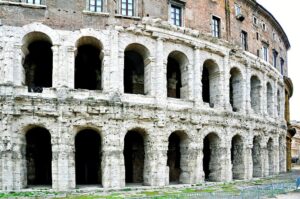
Stone was a fundamental building material in ancient Rome, with various types employed for different purposes. Common stones included travertine, tufa, and marble, each selected for its specific characteristics. Travertine, a durable limestone, was often used in structures like the Colosseum. Tufa, a volcanic rock, was favored for its lightweight and easy-to-cut nature, making it suitable for foundations. Marble, although more expensive, was used for decorative elements and facades, particularly in temples and public buildings. The Romans also imported high-quality marbles from across the empire. The choice of stone was influenced by factors such as local availability, cost, and the intended use of the structure.
Brick

Brick-making in ancient Rome evolved significantly during the Empire. Initially, Romans used sun-dried mudbrick, which was less durable. The introduction of fired clay bricks marked a turning point, allowing for stronger and more versatile construction. The earliest known use of fired bricks in Rome dates to the Theatre of Marcellus, completed in 13 BC. Roman bricks were typically longer and flatter than modern bricks, with various shapes and sizes. The mass production of bricks facilitated large-scale building projects, and bricks were often stamped with marks indicating their origin. This practice not only provided a means of dating structures but also reflected the organization of brick production within the empire.
Concrete
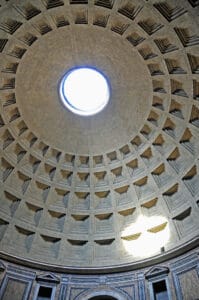
Roman concrete, known as opus caementicium, was a significant advancement in building technology. This material combined lime mortar with aggregates such as volcanic ash, allowing for strong and durable structures. The use of pozzolana, a volcanic ash, enhanced the concrete’s strength and water resistance. Roman concrete was versatile, enabling the construction of complex forms like arches and domes. The Pantheon, with its massive unreinforced concrete dome, exemplifies the material’s capabilities. The Romans utilized concrete in various applications, including aqueducts, bridges, and public baths. Its ability to set underwater made it particularly useful for marine construction. The widespread use of concrete transformed Roman architecture, allowing for innovative designs and large-scale projects.
Wood and Its Applications
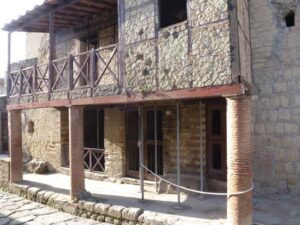
Wood was another material in Roman construction, used for various structural and decorative purposes. The Romans employed different types of wood, each selected for its specific properties. Timber was commonly used for roofs, floors, and scaffolding. The architect Vitruvius provided guidelines on the selection and treatment of wood, emphasizing the importance of using properly aged timber. Wood was also utilized in the construction of war machinery and other functional structures. Joinery techniques developed by the Romans allowed for strong interlocking wooden beams, enhancing the stability of wooden structures. While stone and concrete dominated monumental architecture, wood played a crucial role in everyday construction and domestic settings.
Wood in Roman Architecture: Uses, Techniques, and Limitations
Ceramics and Terracotta
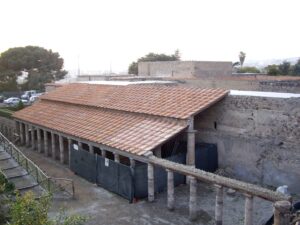
Ceramics and terracotta were widely used in Roman architecture, particularly for roofing and decorative elements. Terracotta tiles provided waterproofing for roofs, while ceramic materials were employed in various construction applications. The Romans also utilized ceramics for plumbing, creating pipes and drainage systems that facilitated water management in urban areas. The use of ceramics extended to decorative arts, with intricate tile work and mosaics enhancing the aesthetic appeal of buildings. Archaeological findings reveal the extensive use of ceramics in both public and private structures, indicating their importance in Roman architectural practices. The versatility of ceramics allowed for a range of applications, contributing to the overall functionality of Roman buildings.
Marble
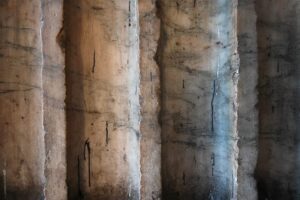 Marble was one of the most prestigious and symbolically charged building materials in ancient Rome. Though not as structurally essential as concrete or brick, marble played a critical role in expressing imperial wealth and authority. It was used extensively for cladding buildings, crafting columns, and sculpting statues, especially in temples, basilicas, and public monuments. Local marbles, such as Luna (Carrara), were quarried in Italy, while imported varieties, like Proconnesian from Asia Minor or Numidian yellow from North Africa, decorated elite structures throughout the empire. Marble was valued not only for its strength and polish but also for its color and grain, with specific types often chosen to convey messages of power, exoticism, or divine favor. Its transportation and use reflected a high degree of logistical planning, as well as the reach of Roman infrastructure.
Marble was one of the most prestigious and symbolically charged building materials in ancient Rome. Though not as structurally essential as concrete or brick, marble played a critical role in expressing imperial wealth and authority. It was used extensively for cladding buildings, crafting columns, and sculpting statues, especially in temples, basilicas, and public monuments. Local marbles, such as Luna (Carrara), were quarried in Italy, while imported varieties, like Proconnesian from Asia Minor or Numidian yellow from North Africa, decorated elite structures throughout the empire. Marble was valued not only for its strength and polish but also for its color and grain, with specific types often chosen to convey messages of power, exoticism, or divine favor. Its transportation and use reflected a high degree of logistical planning, as well as the reach of Roman infrastructure.
Marble in Ancient Rome: Types, Sources, and Symbolism
Metals
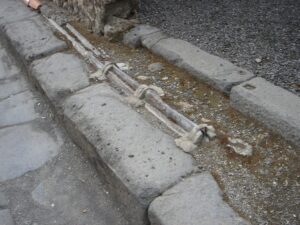
Metals were used in Roman architecture primarily for structural reinforcement and decorative elements. Iron and bronze were commonly employed for tools, fasteners, and fittings. The use of lead in plumbing systems was notable, although it raised health concerns due to potential lead poisoning. Metal was often used in conjunction with other materials, providing strength and durability to structures. The Romans developed advanced techniques for working with metals. While metals were generally more expensive than other materials, their application was essential for specific functions, particularly in public buildings and infrastructure.
Conclusion: The Integration of Materials
The Romans demonstrated a comprehensive understanding of the properties and applications of materials used. Roman building materials included stone, brick, concrete, wood, ceramics, marble , and metals. This knowledge allowed them to construct a wide range of structures, from monumental public buildings to everyday homes. The choice of materials was influenced by factors such as local availability, cost, and the intended use of the structure.
Read more about other key aspects of the Roman Empire:
- Ancient Roman Architecture and Its Legacy
- Ancient Roman Economy: Economic Insights of Ancient Rome
- Ancient Roman Coin Abbreviations
- Indo-Roman Maritime Trade
- Roman Maritime Symbolism
- Roman Mining
- Roman Ports and Maritime Infrastructure
- Roman River Networks
- Seaborne Trade in the Roman Empire: Routes, Ships, and Seasonal Logistics
- The Evolution of Roman Currency: A Historical Overview
- The Roman Navy and Maritime Security
- Borders of the Roman Empire
- Climate of the Roman Empire
- Demography of the Roman Empire
- Honorary Titles for Cities in the Roman Empire
- Languages of the Roman Empire
- Understanding Roman Law: Structure and Influence